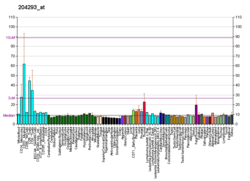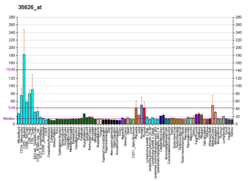SGSH
| SGSH | |||||||||||||||||
|---|---|---|---|---|---|---|---|---|---|---|---|---|---|---|---|---|---|
|
|||||||||||||||||
| Identifiers | |||||||||||||||||
| Aliases | SGSH, HSS, MPS3A, SFMD, N-sulfoglucosamine sulfohydrolase | ||||||||||||||||
| External IDs | MGI: 1350341 HomoloGene: 167 GeneCards: SGSH | ||||||||||||||||
|
|||||||||||||||||
| RNA expression pattern | |||||||||||||||||
 
|
|||||||||||||||||
| More reference expression data | |||||||||||||||||
| Orthologs | |||||||||||||||||
| Species | Human | Mouse | |||||||||||||||
| Entrez |
|
|
|||||||||||||||
| Ensembl |
|
|
|||||||||||||||
| UniProt |
|
|
|||||||||||||||
| RefSeq (mRNA) |
|
|
|||||||||||||||
| RefSeq (protein) |
|
|
|||||||||||||||
| Location (UCSC) | Chr 17: 80.21 – 80.22 Mb | Chr 11: 119.34 – 119.36 Mb | |||||||||||||||
| PubMed search | |||||||||||||||||
|
|
|||||||||||||||||
n/a
n/a
N-sulphoglucosamine sulphohydrolase is an enzyme that in humans is encoded by the SGSH gene.
A number sign (#) is used with this entry because the phenotype is caused by mutation in the gene encoding N-sulfoglucosamine sulfohydrolase (SGSH; MIM 605270). The Sanfilippo syndrome, or mucopolysaccharidosis III, is a lysosomal storage disease due to impaired degradation of heparan sulfate. MPS III includes 4 types, each due to the deficiency of a different enzyme: heparan N-sulfatase (type A); alpha-N-acetylglucosaminidase (type B; MIM 252920); acetyl CoA:alpha-glucosaminide acetyltransferase (type C; MIM 252930); and N-acetylglucosamine 6-sulfatase (type D; MIM 252940). The Sanfilippo syndrome is characterized by severe central nervous system degeneration, but only mild somatic disease. Onset of clinical features usually occurs between 2 and 6 years; severe neurologic degeneration occurs in most patients between 6 and 10 years of age, and death occurs typically during the second or third decade of life. Type A has been reported to be the most severe, with earlier onset and rapid progression of symptoms and shorter survival.
...
Wikipedia
